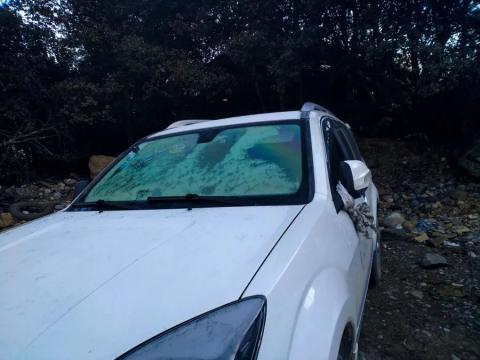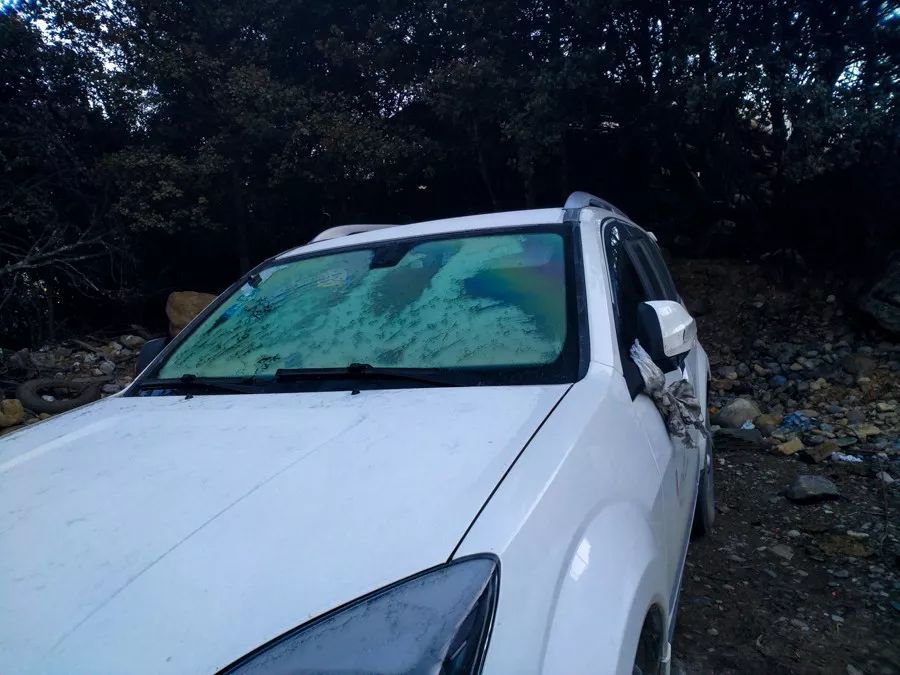
On April 16, 2018, we set off from Nima Hotel. The early morning in the Tibetan area was extremely cold, and our car windows were covered with thick frost. It took us a long time to warm up before driving away.

On the way out of the scenic area, you will pass by Basongcuo. When you came yesterday, it was a bit late and you didn’t stop. Today we plan to see the real Basongcuo.
When we arrived at the famous island in the middle of the lake in Basongcuo, the water was very clear and quite beautiful, but we had seen too many such lakes and we no longer felt cold, so we were not too excited.



After wandering around Basongcuo for about two hours, we went out.
The owner of Nima Hotel is still soliciting customers at the entrance of the scenic spot. After seeing us, he helped us get back the driver fee charged by the scenic spot. I don’t know if the driver of a private car entering the scenic spot needs to charge if the scenic spot is open normally, but at least the owner of this hotel will still think about it, and breakfast is free. You know, eating a delicious breakfast in Tibetan areas is very expensive. (except Lhasa).
We arrived in Lhasa soon after leaving the scenic spot that day. Everything was still the same, familiar streets, familiar Tibetans, and familiar prayer wheels.
Lhasa, the city of sunshine, always makes people lazy. We rarely go out during these days, so we just sit quietly, basking in the sun and chatting. It is a rare and pleasant time.
But at the same time, I kept reminding myself that I must be wary of this kind of comfort, as it would be difficult to be swallowed by it. Again This may be because we have stayed in big cities for a long time, which makes us yearn for comfort and at the same time be wary of it.
A friend took us to a temple, whose name forgot . Here you can see the panoramic view of Lhasa, which is a good place to take pictures of star trails. The peach blossoms in the temple are blooming.





I heard from friends that eminent monks who passed away in this temple are buried in these pagodas in the temple. I don’t know if this is true.
During this time in Lhasa, we didn’t stay idle all the time. In order to expand the hotel, our friend’s inn had to change the kitchen into a double room, and we also followed suit.

As the daughter of a carpenter, she couldn't use a saw well, and she was also drunk.

The renovated room has been decorated and looks pretty good. Unfortunately, no image of the original kitchen has been left.
During that time, we would drink tea and chat here every night. My friend asked us the purpose of our visit. In fact, our original purpose was because other places were not interesting and we still felt like Tibet. OK, here it comes. But after I came here, my thoughts started to flourish again, and I wanted to go to Xinjiang.
As early as the beginning of the plan, except for Xinjiang, we had to go to other places in China. Everyone knows the reasons. Although we have heard from friends that Xinjiang is very safe now, we are still a little scared. After all, most of the people who told us that it is very safe only went to a local scenic spot with a group, which they said they had already visited. If we follow our current gameplay and drive wherever there are fewer people, the risk factor will inevitably increase.
The owner of the inn kept urging us not to go, but after a few days of not-so-considered thinking, we decided to have a go.
"Fat Man" is what we call him. He is from Jinan. He runs the engine oil business in Qinghai, Tibet, Xinjiang and other places, and often travels between places. I heard that we were going to Xinjiang, so he specifically told me some Xinjiang "recipes" and repeatedly emphasized that we must eat what he recommended, otherwise we will regret it.
The conversation was in full swing when one of Fatty's Xinjiang customers who was doing well called him. Fatty casually asked about the current situation in Xinjiang. After hanging up the phone, the fat man became serious and relayed the situation there to us, as well as his suggestions...
Friends who told us it was safe before started to advise us not to go. We were actually in a good state at the time because we had already decided to go and had no plans to change it. We just wanted to keep the route as conservative as possible.
The next day, Fatty said he received a text message from a committee where the mobile phone number was located.

When chatting with friends in Lhasa before, whenever politics came up, our Uncle Carrot would interrupt us and remind us not to talk about it. He also talked about scenes similar to those in 007. At the time, I thought it was impossible. I guess. You're kidding us. But after contact and more understanding, we found that this is not alarmist.



The weather in Tibetan areas is always changing like this. The sun is often shining brightly, but soon rain and snow will come.
Before departure, let’s decorate the outside of the small house we worked hard to renovate.

Don't think blindly, I didn't draw this, I just helped trace it.


The signature in the lower left corner is that of this great god, and it is because of him that we have a new understanding of talent.
We stayed in Lhasa for a month and a half this time, and set off again on May 25, 2018, heading to Xinjiang. This time we took the Ali South Line, which is already a very mature route. When we were taking the southern route, our friends told us that the northern route in Ali had also built asphalt roads and the road conditions were particularly good. However, the northern route passed through fewer counties, so supplies were a bit difficult.
The Northern Line is very close to the uninhabited land. Before I left, I saw a news saying that a couple got off the road on the Northern Line and accidentally drove into a swamp. There was no signal on the road. Rescue didn't come until the next day. Fortunately There are supplies in the car. If you have to walk to find rescue, you may not be able to find the village even if you walk for a day, and there may be an accident at night. So if you choose to go to an inaccessible place, you must be careful.
Sometimes we encounter extreme weather here. For example, it is sunny or even a little hot in the county. When we reach the pass, there is heavy snow or even blizzard. Heavy fog or sandstorms are also common.
The video below was taken near Payang. Fortunately, the terrain was very flat at that time, and we found that in dusty weather, using a mobile phone to see the road is much clearer than with the naked eye. It is also because of this discovery that in the future, we will In fog or other extreme weather, we will use this method to find our way.
Before leaving, my friend in Lhasa looked envious. She had been in Tibet for many years and had never been to Ngari, which was pitiful. After some research, we decided to pack up the camera case, make room, and take her around, which fulfilled our wish.
I have walked this route back and forth several times, and I am no longer as careful as I was the first time. The first trip took three days, but now it’s just one day. It’s just that the section from Lhasa to Shigatse has a lot of speed restrictions, which may be the reason for the frequent accidents. There are interval speed measurement, mobile speed measurement, fixed speed measurement, and there are cameras all along the road.

The first time I went to Ali, I didn’t stop to take pictures when I drove to this sign. I didn’t realize it until I passed by. I couldn’t miss it this time.

We prepared a lot of hot pot base ingredients in the car. Hot pot food in Tibetan areas is very expensive and we still don’t have enough to eat, so making your own hot pot meal is the perfect solution.

Not only is food expensive in Tibet, but gasoline is also very expensive. Especially in Ali area, every time you fill up your car All Feel Heart Dripping blood.

The most common This is the Tibetan wild donkey, a social animal, stupid and silly, very cute.

The ruddy shelduck is also a common bird. It should be a relative of the duck. It can fly and is quite beautiful.


zada tulin








The "center of the world" in Hinduism - Kailash .
Related reading: What you must know about Angkor Wat





She has a very interesting name, "Langcuo" .


Dagejia Geyser is recommended to everyone. It is located in Sangsang District of Angren County . You can see it by carefully looking at the roadside signs when taking the southern route. The road conditions are very good. You can go directly to Ali North Line . The altitude is 5080 meters. For those of us who have basically adapted to the high altitude, we don’t feel much anymore, but I suggest everyone go in the morning . Tibetan areas are relatively The wind is much lighter in the afternoon, and too much wind can easily cause high reflexes.
The first time I saw this geyser, I was really surprised. Long River There are dozens of springs of various sizes on both sides of the valley. According to the introduction, this is the largest geyser group in China. Moreover, the water temperature of some springs here can reach 85 degrees, which would be nearly 100 degrees in the plains.
This is the largest spring, with a diameter of about 30 centimeters. It is very active and its activity patterns are also very diverse. Unique. Each eruption is 1 to 2 meters high, up to 10 meters high, and can last for as long as 10 minutes or as short as a moment.

Before each major eruption, the water level at the mouth of the spring and the hot water pool next to it slowly rises, and then the spring mouth erupts. The water column rises from low to high, and sometimes reaches the stage of violent eruption after several repetitions. The mouth of the spring is covered with dense hadas. Maybe they think the existence here is a gift from the gods.

After that, we went to Dagjia many times. We only saw one violent eruption of this largest spring, which was actually not as frequent as the introduction. Tibetans here often take a bath in the small spring. It seems that hot springs always have some rumors of healing effects in China.

















































On the 395th day of on the road, we stayed overnight in Saga.
